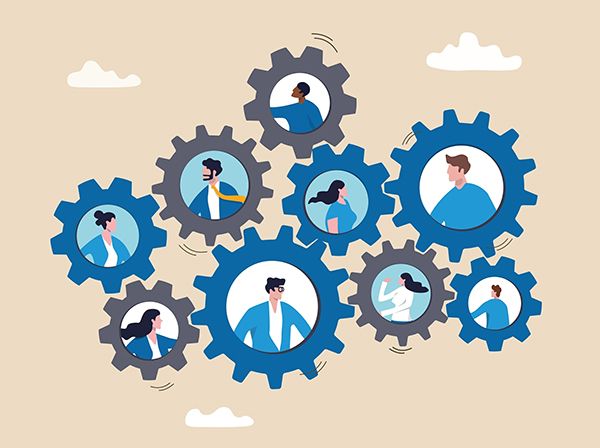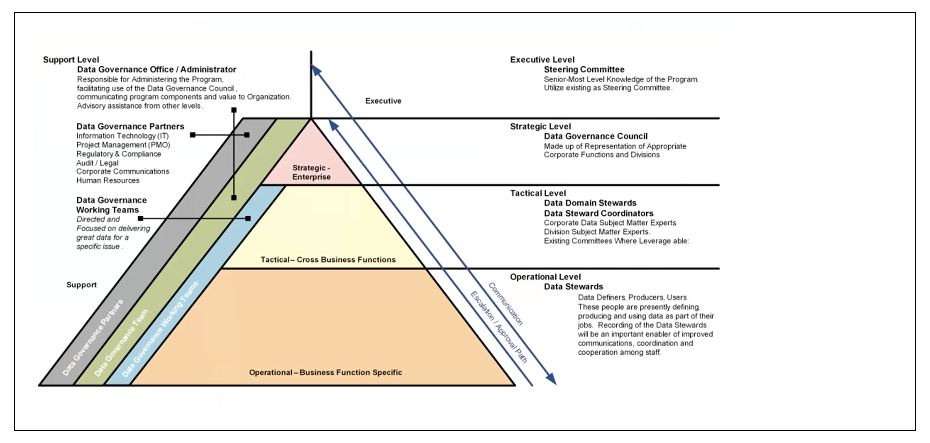

Data Governance, a formalized practice that executes and enforces company-wide data policies, has gained significant traction in the last few years. As of 2022, 81.89% of the participants in a DATAVERSITY® Trends in Data Management(TDM) survey have either implemented a Data Governance program or plan to initiate one. Yet, 54.63% of those surveyed listed a lack of Data Governance as a major Data Management challenge. Better clarity around roles and responsibilities promises more success in getting value from Data Governance.
Bob Seiner, president and principal of KIK Consulting and Educational Services, suggests adopting the mindset that “everyone is a data steward,” a person with formal accountability for their relationship to data whether defining, producing, or using it. The key to good Data Governance is to know what a person does and needs as a data steward. Read on for more on how to construct and support these Data Governance roles and responsibilities.
Activate Data Governance Roles and Responsibilities
By initially activating existing roles instead of assigning them, Seiner believes that enterprises have an edge in influencing acceptance among workers. That way, organizations take stock of what exists before adding additional work that employees can see as a burden.
Many personnel already do Data Governance tasks before a company formalizes it. For example, every employee working with health or financial information has stewardship when using it to stay compliant with U.S. laws. Furthermore, a security office creates and distributes training around these tasks to protect data.
Seiner recommended taking these people who demonstrate existing activities governing data and acknowledging their contribution to Data Governance formally. In the process, have them identify themselves in the Data Governance model or position chart.
Even with existing roles, sometimes companies will require additional Data Governance responsibilities – such as those to integrate policies across the organization. So, designate any new activities and assign them by expanding or creating new roles in the company. Additionally, clarify any expectations, including:
- How much of their time will they need to give?
- How often will they meet?
- Is it a group or individual role?
- Who does the position report?
- With whom does the position coordinate?
Determine Data Governance Roles and Responsibilities
Once business leaders understand how to acknowledge existing Data Governance roles and responsibilities and take a light touch in adding new responsibilities, they can better comprehend Data Governance operations and how to do them. Bob Seiner has created an “Operating Model of Roles and Responsibilities” to further guide those companies.
His clients use his diagram as a starting point and have found it helpful. See the image below:


In the picture, Data Governance roles span four tiers of expected deliverables and accountability: executive, strategic, tactical, and operational. Additionally, these groups have a support structure that administrates and advises them, making Data Governance tasks across the organization more manageable.
Executive Level
Executive-level roles include leadership in the C-suite at the organization’s top. According to Seiner, people at the executive level support, sponsor, and understand Data Governance and determine its overall success and traction.
Typically, these managers meet periodically as part of a steering committee to cover broadly what is happening in the organization, so they would add Data Governance as a line item, suggested Seiner. These senior managers take responsibility for understanding and supporting Data Governance. They keep up to date on Data Governance progress through direct reports and communications from those at the strategic level.
Strategic Level
Those at the strategic level represent each business function and typically form a Data Governance Council. This panel meets regularly and establishes data policies.
According to Seiner, strategic members take responsibility for learning about Data Governance, reporting to the executive level about the program, being aware of Data Governance activities and initiatives, and attending meetings or sending alternates.
Moreover, this group has the power to make timely decisions about Data Governance policies and how to enact them. These abilities give strategic roles the means to handle Data Governance issues brought by those at the tactical level and make final decisions about those escalations.
Strategic roles also communicate with colleagues and managers about how Data Governance works for the organization and its future. In addition, this team takes responsibility for its overall value.
Tactical Level
Subject matter experts (SMEs) accountable for data across business units comprise the tactical category. Seiner suggests thinking of them as “facilitators for cross-business unit resolution of data definition, production, and usage issues.”
Depending on the organization, tactical members may be able to decide on Data Governance issues and implement their recommendations. However, if they do not have that power, SMEs need to escalate the problems to the strategic level and ensure they are well documented. With any Data Governance solution, the SME’s affiliation to a business unit comes secondary.
Jimm Johnson, the Data Governance manager at HireRight, describes four additional SME functions:
- Maintaining and sharing insider knowledge about “institutional data processes” by coaching or training others
- Matching the rules and standards for Data Governance maintenance to business needs
- Applying Data Governance rules and standards to meet or exceed an acceptable threshold for Data Quality
- Assisting others and cultivating buy-in when an enterprise embarks on new initiatives
Successful SMEs have strong technical, social, and leadership traits when covering these responsibilities. People’s skills and experiences typically span business and IT, bridging simple and complex information. Additionally, those at the tactical level motivate the organization to adopt new behaviors by generating excitement with data.
Operational Level
As Seiner explains, “The operational group covers everyone whose work impacts an organization’s data – all employees and the data stewards who are the eyes and ears of data.”
Every worker participates in ensuring good data definitions and values, following the rules to identify and classify data access, identifying and documenting regulatory issues with the data, exchanging knowledge with colleagues and managers, and communicating new/changed business requirements to the business units impacted and concerns to those at the tactical levels.
Operational responsibilities will diverge depending on whether someone defines, produces, or uses organizational data. Those at the operational level may have a different title than data steward. As Seiner says, they must realize that “if they are accounting for and protecting data, then they steward data and must be responsible for their data activities.”
Support Level
Support members run the Data Governance program along with assistance from partners. They may consist of a few people in a Data Governance Office (DGO) or an administrator, like a CDO.
Seiner emphasizes that as a Data Governance lead or manager, this role is critical to getting Data Governance done. While a program team will eventually emerge to determine how to build Data Governance, it does not have the same resources and functionality as the DGO to participate in all Data Governance program development activities and facilitate Data Governance Council meetings and teams toward resolving issues.
Additionally, the DGO or administrator reports results (such as Data Quality metrics or Data Governance adoption) to the strategic level. They work with partners who are invested in Data Governance activities, which can include:
- Security
- Information technology (IT)
- Project managers (PMO)
- Regulatory and compliance teams
- Audit/legal
- Corporate communications
- Human resources (HR)
Think of partners as part of a larger governance planning team where Data Governance is an aspect of their role and needs support from a DGO or administrator.
Customizing Data Governance Roles and Responsibilities
Not every company has the same resources or structures for Data Governance roles and responsibilities. For example, a smaller organization may not have a corporate communications office or one group representing strategic and tactical responsibilities. Instead, a single person takes on both roles.
Seiner acknowledges these differences and encourages organizations to customize his Operating Model of Roles and Responsibilities as needed. However, he suggests keeping data ownership with any businesspeople and keeping consistent formatting when modifying his diagram.
Additionally, he advises keeping a similar format by using the spacing of each level in his pyramid to indicate the status of direct decision-making with company data. He also suggests keeping the colors consistent for each group so that when a tier is pulled out for another presentation, the audience can identify it.
Conclusion
Getting the right people involved with the right activities increases a company’s success with Data Governance. In many cases, roles and responsibilities with Data Governance already exist but require recognition.
Acknowledge any new roles and responsibilities before assigning people to them. Ensure they have clear expectations and support from the DGO, an administrator, or updated pay to take on any additional workload.
With the appropriate support, Data Governance roles and responsibilities function at four levels: executive, strategic, tactic, and operational. While each grouping in this Operating Model of Roles and Responsibilities performs a critical function, an organization can change the details to suit its needs.
Image used under license from Shutterstock.com
- SEO Powered Content & PR Distribution. Get Amplified Today.
- PlatoAiStream. Web3 Data Intelligence. Knowledge Amplified. Access Here.
- Minting the Future w Adryenn Ashley. Access Here.
- Buy and Sell Shares in PRE-IPO Companies with PREIPO®. Access Here.
- Source: https://www.dataversity.net/data-governance-roles-and-responsibilities/
- :has
- :is
- :not
- :where
- $UP
- 2022
- 224
- a
- abilities
- Able
- About
- acceptable
- acceptance
- access
- According
- accountability
- accountable
- Accounting
- acknowledge
- across
- activating
- activities
- add
- adding
- addition
- Additional
- Additionally
- adopt
- Adopting
- Adoption
- All
- along
- already
- also
- among
- an
- and
- Another
- any
- appropriate
- ARE
- around
- AS
- aspect
- Assistance
- At
- attending
- audience
- aware
- BE
- before
- being
- believes
- below
- Better
- bob
- both
- bridging
- broadly
- brought
- build
- burden
- business
- but
- by
- C-suite
- CAN
- cases
- Category
- challenge
- change
- Chart
- clarity
- Classify
- clear
- clients
- coaching
- colleagues
- comes
- committee
- communicate
- communicating
- Communications
- Companies
- company
- Company’s
- complex
- compliance
- compliant
- comprehend
- Concerns
- consistent
- construct
- consulting
- contribution
- coordinate
- Corporate
- Council
- cover
- covering
- covers
- created
- creates
- Creating
- credit
- critical
- customize
- data
- data access
- data management
- data quality
- DATAVERSITY
- Date
- decide
- Decision Making
- decisions
- Defines
- defining
- definitions
- demonstrate
- Depending
- details
- Determine
- Development
- differences
- different
- direct
- Diverge
- do
- documenting
- does
- done
- each
- Edge
- educational
- either
- emerge
- emphasizes
- Employee
- employees
- encourages
- ensure
- ensuring
- Enterprise
- enterprises
- establishes
- eventually
- Every
- everyone
- example
- exceed
- exchanging
- Excitement
- Executes
- executive
- exist
- existing
- exists
- expanding
- expectations
- expected
- Experiences
- experts
- Explains
- Eyes
- facilitate
- few
- final
- financial
- financial information
- following
- For
- form
- formal
- Formally
- format
- found
- four
- from
- function
- functionality
- further
- Furthermore
- future
- gained
- generating
- getting
- Give
- good
- governance
- governing
- Group
- Group’s
- guide
- handle
- Happening
- Have
- he
- Health
- helpful
- his
- How
- How To
- However
- hr
- HTML
- HTTPS
- identify
- identifying
- if
- image
- impacted
- Impacts
- implement
- implemented
- in
- include
- Including
- Increases
- indicate
- individual
- influencing
- information
- initially
- initiate
- initiatives
- Insider
- instead
- integrate
- invested
- involved
- issues
- IT
- ITS
- Johnson
- jpg
- Keep
- keeping
- Key
- Know
- knowledge
- Lack
- larger
- Last
- Laws
- leaders
- Leadership
- learning
- Level
- levels
- License
- light
- like
- Line
- Listed
- maintenance
- major
- make
- Making
- management
- manager
- Managers
- many
- Matter
- max-width
- May..
- means
- Meet
- meetings
- Meets
- Members
- Metrics
- Mindset
- model
- more
- much
- must
- Need
- needed
- needs
- New
- of
- Office
- often
- on
- ONE
- operating
- operational
- Operations
- or
- organization
- organizational
- organizations
- Others
- out
- overall
- ownership
- panel
- part
- participants
- participate
- participates
- partners
- Pay
- People
- people’s
- performs
- person
- Personnel
- picture
- plan
- planning
- plato
- Plato Data Intelligence
- PlatoData
- Point
- policies
- position
- power
- practice
- presentation
- president
- Principal
- problems
- process
- Production
- Program
- Progress
- promises
- protect
- protecting
- Pyramid
- quality
- Read
- realize
- recognition
- recommendations
- recommended
- regularly
- regulatory
- relationship
- report
- Reporting
- Reports
- represent
- representing
- require
- Requirements
- Resolution
- resolving
- Resources
- responsibilities
- responsibility
- responsible
- Results
- right
- Role
- roles
- rules
- Run
- s
- same
- says
- secondary
- security
- see
- sending
- senior
- Services
- sharing
- shutterstock
- significant
- similar
- Simple
- single
- skills
- smaller
- SME
- SMEs
- So
- Social
- solution
- Someone
- span
- sponsor
- standards
- Starting
- Status
- stay
- Stewardship
- stock
- Strategic
- strong
- structure
- success
- such
- Suggests
- Suit
- support
- Supporting
- surveyed
- tactical
- Take
- takes
- taking
- tasks
- team
- teams
- Technical
- Technology
- than
- that
- The
- their
- Them
- themselves
- then
- These
- they
- Thinking
- this
- those
- threshold
- Through
- tier
- time
- Title
- to
- top
- touch
- toward
- traction
- Training
- Trends
- typically
- u.s.
- under
- understand
- understanding
- unit
- units
- updated
- Usage
- use
- used
- uses
- using
- value
- Values
- Way..
- WELL
- What
- What is
- when
- whether
- which
- while
- WHO
- whose
- will
- with
- Work
- worker
- workers
- working
- works
- would
- years
- yet
- zephyrnet












